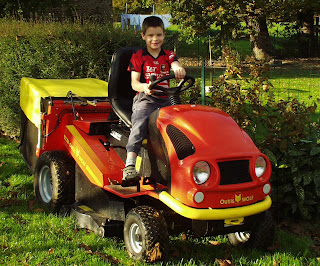In our commune (village) there are 1000 habitants, so not so big, however there are 34 farms in the commune - so a large proportion of farmers. My partner, Yves, is a dairy farmer with around 50 hectares (100 acres) and 45 milking cows. Most of his fields are either pasture for the cows and heifers, or sown as maize for silaging forage for the cows to eat. The remaining fields (this year 8 hectares) are sown with wheat, mainly for the straw for the bedding in the winter, but also to sell the wheat. This week has seen the harvest start for Yves, it has been going on all around us for about three weeks, but as most of the farmers are small business, they cannot afford to buy large machinery like combine harvesters, so have to use contractors. The problem here is that everyone wants the contractor to come and harvest on the first sunny day that the wheat is ripe, so Yves has had to wait his turn.
 In the mornings, the dew is heavy in Brittany, so generally it is not possible to start combining until after 3pm when the dew has been dried off, then all is clear (weather permitting) until the dew falls again, normally at about 4.30am. Yves' first slot came at about 10pm on Sunday evening (very sociable!!). So we all went along to watch the Fiat combine start his large field of 6.5 hectares. The Fiat is very small and very old (it literally clatters along!), it has a cutting width of 3 meters as opposed to the modern machines of 5 or 6 meters, although the larger machines get the job done quicker, they have to process the wheat a lot quicker, so this means threshing it much more violently - this tends to break the straw and give a poorer quality bedding.
In the mornings, the dew is heavy in Brittany, so generally it is not possible to start combining until after 3pm when the dew has been dried off, then all is clear (weather permitting) until the dew falls again, normally at about 4.30am. Yves' first slot came at about 10pm on Sunday evening (very sociable!!). So we all went along to watch the Fiat combine start his large field of 6.5 hectares. The Fiat is very small and very old (it literally clatters along!), it has a cutting width of 3 meters as opposed to the modern machines of 5 or 6 meters, although the larger machines get the job done quicker, they have to process the wheat a lot quicker, so this means threshing it much more violently - this tends to break the straw and give a poorer quality bedding.
They worked through the night and had to finish at 4am in the morning because of rain. There is still one and a half hours combining left to do.
 On Monday evening he had a smaller field to harvest, but there was lots of bindweed entwined in the wheat, so this required the bigger machine, which could cope with the weed.
On Monday evening he had a smaller field to harvest, but there was lots of bindweed entwined in the wheat, so this required the bigger machine, which could cope with the weed.
Hugh went along with his toy combine to help as well - you can see the similarity.
 went downstairs, but could see no bird, so I pulled down the flue that covers most of the tube. After an hour or so I could hear the noises increasing, and out popped a Tawny Owl (Une chouette, which incidentally also means smart or great).
went downstairs, but could see no bird, so I pulled down the flue that covers most of the tube. After an hour or so I could hear the noises increasing, and out popped a Tawny Owl (Une chouette, which incidentally also means smart or great). ed to move it, so donned some thick gloves and put it in the wood shed. I thought that it would fly away during the night, but the following day it was still there, bearly moving. Oh dear, it was surely suffering from shock, my daughter wanted me to find a dead mouse to feed it, but not have too many dead mice in stock, I left it for another night. Happily it flew during the night and now I can hear it twit-t wooing in the oak tree in front of the house each night. I like happy endings!
ed to move it, so donned some thick gloves and put it in the wood shed. I thought that it would fly away during the night, but the following day it was still there, bearly moving. Oh dear, it was surely suffering from shock, my daughter wanted me to find a dead mouse to feed it, but not have too many dead mice in stock, I left it for another night. Happily it flew during the night and now I can hear it twit-t wooing in the oak tree in front of the house each night. I like happy endings!













